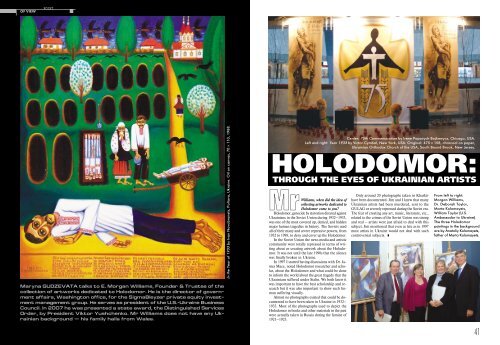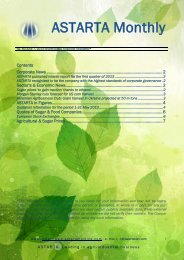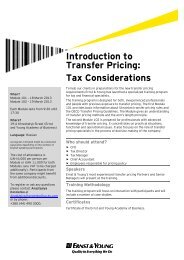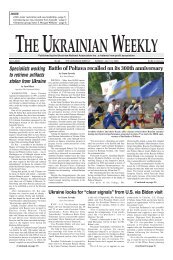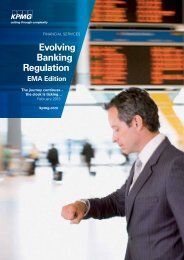HOLODOMOR: - US-Ukraine Business Council
HOLODOMOR: - US-Ukraine Business Council
HOLODOMOR: - US-Ukraine Business Council
- No tags were found...
Create successful ePaper yourself
Turn your PDF publications into a flip-book with our unique Google optimized e-Paper software.
OF VIEWPOINTMaryna GUDZEVATA talks to E. Morgan Williams, Founder & Trustee of thecollection of artworks dedicated to Holodomor. He is the director of govern−ment affairs, Washington office, for the SigmaBleyzer private equity invest−ment management group. He serves as president of the U.S.−<strong>Ukraine</strong> <strong>Business</strong><strong>Council</strong>. In 2007 he was presented a state award, the Distinguished ServicesOrder, by President Viktor Yushchenko. Mr Williams does not have any Uk−rainian background — his family hails from Wales.In the Year of 1933 by Ivan Novobranets, Poltava, <strong>Ukraine</strong>. Oil on canvas, 70 ✕ 110, 1988.Center: 75th Commemoration by Irene Popovych Bojkewycz, Chicago, <strong>US</strong>A.Left and right: Year 1933 by Victor Cymbal, New York, <strong>US</strong>A. Original: 475 ✕ 158, charcoal on paper,Ukrainian Orthodox Church of the <strong>US</strong>A, South Bound Brook, New Jersey.<strong>HOLODOMOR</strong>:THROUGH THE EYES OF UKRAINIAN ARTISTSwhen did the idea ofcollecting artworks dedicated toMrWilliams,Holodomor come to you?Holodomor, genocide by starvation directed againstUkrainians in the Soviet Union during 1932–1933,was one of the most covered up, denied, and hiddenmajor human tragedies in history. The Soviets usedall of their many and severe repressive powers, from1932 to 1998, to deny and cover up the Holodomor.In the Soviet Union the news media and artisticcommunity were totally repressed in terms of writingabout or creating artwork about the Holodomor.It was not until the late 1990s that the silencewas finally broken in <strong>Ukraine</strong>.In 1997 I started having discussions with Dr. JamesMace, noted Holodomor researcher and scholar,about the Holodomor and what could be doneto inform the world about the great tragedy that theUkrainians suffered under Stalin. We both knew itwas important to have the best scholarship and researchbut it was also important to show such humansuffering visually.Almost no photographs existed that could be documentedto have been taken in <strong>Ukraine</strong> in 1932–1933. Most of the photographs used to depict theHolodomor in books and other materials in the pastwere actually taken in Russia during the famine of1921–1923.Only around 20 photographs taken in Kharkivhave been documented. Jim and I knew that manyUkrainian artists had been murdered, sent to theGULAG or severely repressed during the Soviet era.The fear of creating any art, music, literature, etc.,related to the crimes of the Soviet Union was strongand real – artists were just afraid to deal with thissubject. Jim mentioned that even as late as in 1997most artists in <strong>Ukraine</strong> would not deal with suchcontroversial subjects. ➧From left to right:Morgan Williams,Dr. Deborah Taylor,Marta Kolomayets,William Taylor (U.S.Ambassador to <strong>Ukraine</strong>).The three Holodomorpaintings in the backgroundare by Anatoliy Kolomayets,father of Marta Kolomayets.41
42One Cannot Forget by Vira Kuleba-Barynova, Kyiv, <strong>Ukraine</strong>. Oil on canvas, 90 ✕ 120, 2008.So in late 1997 I began a search in <strong>Ukraine</strong> tolook for any artworks about the Holodomor thatexisted and for artists who would be willing, out oftheir family memory and artistic souls, to deal withthe Holodomor and other Soviet crimes.How did you learn about the Holodomor?I first came to <strong>Ukraine</strong> in the early 1990s. I wasnot aware of the Holodomor at that time. Duringmy later visits — I worked in agricultural and agribusinessdevelopment — various people started tellingme about the Holodomor and I became veryinterested in the events of the early 1930s.What artworks were the first in your collection?The first Holodomor artworks I found in Kyivwere 15 outstanding original posters (tempera onboard) created from 1989 to 1993 by poster and graphicartists who had been trained in Soviet timesbut were now willing to break out of the restrictionsof the past. Poster art is a great medium for depictingpolitical and governmental crimes. The posters werecreated for poster exhibitions put on by the artiststhemselves, not by the government. ➧Great Famine in <strong>Ukraine</strong> 1932–33 by Victor Zaretsky, Kyiv, <strong>Ukraine</strong>.Oil on canvas, 130 ✕ 130, 1989.1932–1933 And the Sun is Risen... by Valeriy Viter, Kyiv, <strong>Ukraine</strong>.Tempera on board, 70 ✕ 100, 1999.


